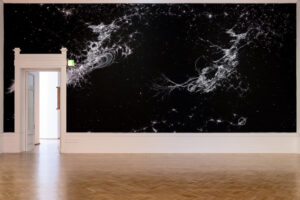The eye must be led through an act of consciousness to intuit what is other than reality and to “visualize” a concept that determines a new form of reflection. If perceiving, conceiving and imagining, are the three elements through which the characters of a phenomenon are outlined, to have, therefore, a consciousness more likely to an Other totality, we must multiply the possible points of view. Until now, it has been customary to consider Nature as a beneficial force from whose resources the human could draw since, thanks to it, «every kind of living is conceived and comes to visit, once born, the lights of the sun»[1]. With the post-modernism, the scientific-technological approach has gradually diverted the human being’s attention from the spiritual and existential one proper to the natural element. To consider an other reality to one’s own ego, renouncing the idea of modern progress, for the human would mean not only to accept his natural finiteness, but also «to return to live immortally through the Life of Nature»[2], then reaching a balance with it.

HOT SPOT – Caring for a Burning World, exhibition view, La Galleria Nazionale d’Arte Moderna e Contemporanea, Rome, 2022. Ph. Adriano Mura, courtesy La Galleria Nazionale d’Arte Moderna e Contemporanea
On the basis of the above, the group show “HOT SPOT – Caring for a Burning World”, curated by Gerardo Mosquera for the Galleria Nazionale d’Arte Moderna e Contemporanea in Rome, features the works of 26 artists and aims at stimulating the genesis of this same reflection. Although this is a strictly contemporary subject, the debate on the causes of climate change does not always leave room to a sense of responsibility or awareness concerning the planet Earth. Rather, this undermines in the human a sense of alienation, sprung precisely from the will to dominate it, that manifests itself cyclically throughout history as a rebound effect of the great technological advances. Conversely, it is also true that transforming the subject of reflection, through the work of art, from an alarming political denunciation to a more critical reasoning or a more aesthetic activism, leaves room for a wider plurality of interpretation. The opening work of the exhibition, “Hot Spot III”, by Mona Hatoum, a monumental hemisphere made of iron and red neon, revolves around itself at the center of the principle hall in the Roman Gallery as a concrete symbol of how the conflicts of modern society are causing an inevitable environmental disaster. The disruptive act of action-reaction is then amplified by Kim Juree’s work “Flooded”, where a clay architecture slowly dissolves subjugated by the force of water. If on the one hand in Juree’s piece the water element dissolves the artificial matter, in Sandra Cinto site-specific work, “Night of Hope”, it creates a liquid cosmology that, suspended, floats brightly in a dark firmament.

HOT SPOT – Caring for a Burning World, exhibition view, La Galleria Nazionale d’Arte Moderna e Contemporanea, Rome, 2022. Ph. Adriano Mura, courtesy La Galleria Nazionale d’Arte Moderna e Contemporanea
The sense of deep alienation is experienced by the individual not in seeing their habitat disintegrated, but more in the inability to curb their aware desire for omnipotence. The distancing from naturalness and spirituality – not to be expressly understood in a religious key – in favor of a techno-scientific or even conceptual “progress” create in the human the false illusion of escaping death and its eternal return. Emblematic is, indeed, the film work by the duo Ibeyi. The artists, lying on the ground, invoke Ochùn – divinity of the river – in a melodic song. This gently submerges them in its waters in a slow and inevitable archetypal return from earth to water. Secluded and more hidden, instead, is the video “O Peixe” by Jonathas De Andrade, in which the human empathy turns into a disturbing and dark image of a fisherman who hugs a freshly caught fish. The warmth and attachment of the gesture of love thus become a cruel weapon that leaves the sea creature agonize while dying. De Andrade’s touching work generates a further reflection in the viewer: what if the deepest restlessness was precisely generated by the awareness of one’s own restless nature? The act of conscience is intrinsically the bearer of an immediately certain content: its essence, the same that is for all the human beings, the inescapable indifference of Nature.

HOT SPOT – Caring for a Burning World, exhibition view, La Galleria Nazionale d’Arte Moderna e Contemporanea, Rome, 2022. Ph. Adriano Mura, courtesy La Galleria Nazionale d’Arte Moderna e Contemporanea
The refractoriness of nature to personalization, and its irreducible otherness towards the human are well clarified by John Baldessari. In the video “Teaching Alphabet to a Plant”, 1972, the Californian artist’s hand tries to feed a flower with the letters of the alphabet written on small pieces of paper. In the background, the sounds of the letters that follow one another are doomed to be unanswered, and to get lost in the void like an echo. The logical-linguistic formalization, concretized in the alphabet, is therefore incompatible with the flower, symbol of the concept of nature, equally elusive and deceptive as it is also the result of the abstract and generalizing process implemented by the human. Nature is indifferent to the human beings, and it is, in the final analysis, because it does not exist, except as a sum of characters, as an illusory statistical average. Nature is a necessary untruth, a useful lie to the human who finds, in the presumption of subjecting and ruling all the phenomena to an ultimate meaning, a strategy to escape from the uselessness of their existence.
[1] Lucrezio, De Rerum Natura, Della Natura delle cose, vv 6-7, trad. Alessandro Marchetti, 1975, Giulio Einaudi Editore, Torino.
[2] Vale Palmi, L’Aldilà è un Angolo stretto. Oltre morte dell’arte contemporanea, p.245, Edizioni Pendragon, Bologna.
Info:
Various artists, HOT SPOT– Caring for a Burning World
curated by Gerardo Mosquera
24/10/2022 – 26/02/2023
La Galleria Nazionale
viale delle Belle Arti 131, Rome
lagallerianazionale.com

Graduated in Architectural Sciences at the Sapienza University in Rome, with a master’s degree in Contemporary Art and Management at the Luiss Business School, she currently works as an intern and project manager at Untitled Association. Graduated in Photography and Art Criticism in Bologna, she currently carries on her personal projects and is part of the team of the Forme Uniche cultural project.






NO COMMENT